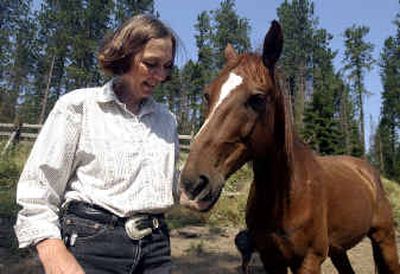‘Beauty contest for horses’

The first animals high-tailing it to the fair this year will take the arena next weekend for the North Idaho Fair Open Horse Show. Nearly 170 horses will be cleaned-up, combed down and ready to ride.
“It’s a beauty contest for horses, while testing their functions and how well they’re put together,” said Becky Sande, show manager. The Open Horse Show, a fair event that started in 1950, will begin at 5 p.m. Friday and continue through Sunday. The event is held every year before the fair opens, so the arena is available for fair events, including the rodeo and demolition derby. During the horse event, various breeds of horses — and a few mules — will compete in halter, performance and games.
But for spectators, some of the 140 class competitions stand out as more exciting than others. While the technical skills of dressage and halter trot go unnoticed by untrained eyes, the carriage driving and jumping sessions are real crowd pleasers, Sande said. Another fun event is gaming, where horses and riders compete by weaving between barrels as fast as possible.
“It’s a chance for people to show all the work they’ve been putting in their horses all year long and share their experiences with others,” said Sande.
The sport is often a family event, with several generations lining the arena stands to watch. Sande’s daughter, Tara Cope, started 4-H when she was 9 years old and competed for about 10 years. Cope worked hard to prepare for the show each year and stabled her horse several times at the fair. She said riders who do well at the show ride six or seven days a week, sometimes twice a day.
But while the show puts out good competition, it’s also the kind of event where you can show a backyard horse just for fun, she said. Cope doesn’t ride in competitions any more but is getting her three kids involved early because she had fun with 4-H and the various competitions.
“It was really good for me as a child,” she said. “Horse showing gives you a lot of values, and it teaches how to work toward goals and stick with something.”
Her oldest daughter, 4-year-old Alivia, is in her third year of showing and 2-year-old Hannah will show for the second time this year. Next year, Cope plans to introduce her 1-year-old son, Samuel, to the sport. The little ones ride while parents and friends lead the horses through the arena. But they don’t skip out on the fashion and are often decked out in mini chaps, vests and helmets. Cope said her kids can’t wait for the next ride at grandma’s house to practice for the show.
“If you tell them too early about the horse show, you’re in trouble,” she said. “Then they ask just about every day if it’s time for the horse show.”
Kids ages 6 and younger get trophies for participating. Top adolescent and adult competitors walk away with belt-buckles and the honor of stabling their horses in the barns during fair time, said Linda Rider, who has helped manage the show with Sande for the past three years. Rider said the show is more than just a competition to determine the pecking order of horses in the region.
“Some horse owners use the fair as a marketing tool,” she said. “That’s the way fairs were supposed to be from way back when.”
She said several sales pitches in newspapers or other forums include fair-winning titles to sway buyers in their direction. Her daughter entered the competitions this year in an effort to sell her horse. Rider said the number of horses in the area hasn’t changed much, but the use of horses has changed, she said. Owners are training year-round for regional horse competitions and the fair, instead of using horses for work on ranches and farms.
Rider, who owns 38 horses, said shows aim to prove the rider’s control of horse posture, travel and thinking. Training for horse shows is vastly different from what she’s used to on the family’s 300-acre ranch, where work horses are trained to think and respond to natural obstacles along trail rides.
Rider cautioned that horses that aren’t used for work can tend to get spoiled, even when they’re trained for the arena.
“There’s lots of backyard, spoiled horses,” she said.
Rider expects nearly 170 entries this year. The event drew 168 entries last year, she said.